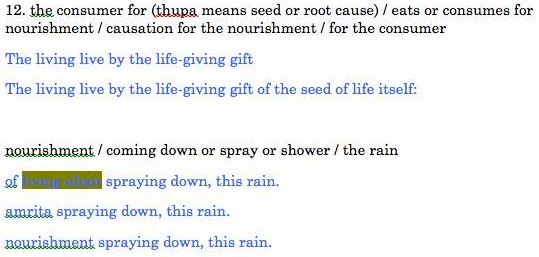A. Anupama, one of our regular contributors, dusts off her translating skills, bringing us hilariously sexy, curiously modern couplets from the classic Tirikkural, a vast book of over a thousand rhyming couplets written in ancient Tamil and dating from about 2,000 years ago. They run the gamut from agricultural advice to law to flirting couples (the most charming).
I thought about you, I said. Then sometimes, you forgot, she reminded,
keeping out of my arms, pretending to be peeved.
A. Anupama gives us a rare glimpse into this ancient world, also providing us with a brief gloss on the difficulties of translation and her modus operandi, plus, joy of joys, some sound files with the original Tamil verse (beautiful liquid sounds) and the English translation.
This is not her first translation effort. See also her “Poems from Kuruntokai” and “Sweet to my heart | Translations of Tamil Love Poems.”
dg
Tirukkural is a collection of 1,330 rhyming couplets (called kural) written by the Tamil poet-saint Tiruvalluvar perhaps around 30 BC (dating is vague). The verses were meant as a comprehensive portrait of Tamil culture, a description but also an epigrammatic guidebook in verse to the formulas of this south Indian civilization. The poems cover every aspect of society and right living from the conduct of kings to the sowing of fields, from aspects of ascetic virtue to the intricacies of lovers’ quarrels, and from the art of friendship to dire warnings against vice.
I gaze at her, admiring her every line, while she scowls
with whom do you compare me, staring like that?
The couplets are organized into chapters of ten each, and the entire work is divided into three sections, Virtue, Wealth, and Love. Tirukkural differs from other classical Indian philosophical literature (e.g., the Yoga Sutras of Patanjali) by not including the fourth section of traditional teaching on spiritual release. Tirukkural emphasizes domestic life over ascetic or religious practice.
The colossal statue of Tiruvalluvar built on a small islet at the meeting of the Indian Ocean, Bay of Bengal, and Arabian Sea, just offshore from the town of Kanyakumari at the southern tip of India, represents the poet’s legendary status. Designed by sculptor V. Ganapati Sthapati, this granite monument stands 133 feet high, representing the 133 chapters of Tirukkural. The height of the statue’s base, at 38 feet, represents the 38 chapters of the first section, Virtue, symbolically setting the foundation of the other two sections, Wealth and Love. The poet is depicted holding up three fingers, a stylized and definitive gesture of Tirukkural’s three sections.
According to tradition, Tiruvalluvar lived in about the first century BCE (though estimates vary by a few hundred years) and was a weaver from Mylapore, near present-day Chennai in the state of Tamil Nadu. The Tamil culture and language are the oldest of Dravidian heritage, originating in the southern tip of India.
Tamil is the oldest living language in the world, with a rich classical literary history. Tiruvalluvar’s work dates from the period of the classical Cankam, a famous gathering of poets, scholars, and sages in the ancient city of Madurai. His poetic couplets are the shortest verse form in Tamil literature, and his work was known and referred to by the writers of classical Tamil epics like Cilappatikaram and Manimekhalai.
If you search YouTube for “kural recitation,” you’ll find videos of young schoolchildren reciting memorized couplets, sometimes with a little prompting, but mostly with ease and confidence. The boy in this video recited chapter 40 from Tirukkural, a set of ten couplets on learning.
On the other hand, centuries of erudite commentary on Tirukkural have revealed its subtlety, and its influence on modern thinkers and writers has been significant. Leo Tolstoy quoted several couplets from it in a letter to an editor at Free Hindustan, a letter that was later translated into Gujarati and published by M.K. Gandhi. Albert Schweitzer said about Tirukkural, “There hardly exists in the literature of the world a collection of maxims in which we find so much of lofty wisdom.”
I couldn’t find a tougher or more rewarding translation challenge than this. Arthur Schopenhauer in his essay “On Language and Words” remarked, “Take translations of authors from antiquity: they are as obvious a surrogate as chicory for coffee. Poems cannot be translated; they can only be transposed, and that is always awkward.”[1] W.S. Merwin in the prologue to his collection Selected Translations, cites advice he received from Ezra Pound: “He spoke of the value of translation as a means of continually sharpening a writer’s awareness of the possibilities of his own language… Pound also urged—at that point and to me, at least—the greatest possible fidelity to the original, including its sounds.”[2] Tirukkural is a particular gift to the translator because in addition to offering fresh mental vistas, it invites one to stricter attention through the voice and the ear.
The couplets, like most proverbs, are designed to be easy to remember and repeat: the alliterative and assonant strength of the compositions aids memory, and tight line-length keeps each verse within a single breath. These same qualities make the couplets difficult to translate, requiring the translator to create equivalencies in sound and sense in a very tight space. Kural 12 showed me quickly how impossible it might be to honor the sound of the original. “Living” sounds nothing like “thupakith,” and yet, the poem in English requires the repetitive transformation of the single word for the purpose of the poem’s sense. The Tamil “Thupaarkuth thupaaya thupaakith thupaarkuth thupaaya” turns into “living,” “live,” “life-giving,” and “life” in my translation.
Still, I found that evoking the original’s sound was possible in many places, with some effort and luck. For example in Kural 18, the “s” sounds in the first line and the “v” sounds in the second line were reproducible, though they lack the alliterative effect of the original. In Kural 20, I added the words “nearness” and “farthest” at the beginnings of the lines to mimic the sounds of the Tamil words “neerindru” and “vaanindru,” which altered the sense only slightly by emphasizing the nuance of distance in the poem’s imagery.
Nearness of rain—without which all worldly work ends, whomever you are.
Farthest skies—without which all natures end.
Word order and integrity of the poetic line are another challenge, because Tamil syntax runs in the opposite direction from English. Subject-verb-object in English often translates to object-verb-subject in Tamil, and even prepositions become postpositions. Sometimes, I could maintain word order, as in Kural 19: “Charity and penance, twins, make their exit from our world, / sky unyielding.” In Kural 20, however, I had to flip word order for sense, translating the two phrases “all worldly work ends” and “all natures end” exactly inverted. The rest of the word order, as well as the couplet’s line integrity, I carefully maintained.
I learned my method of line-by-line translation in Richard Jackson’s translation workshop at Vermont College of Fine Arts in the summer of 2011 when Patty Crane showed us her work translating poems by Tomas Tranströmer. For each line of poetry, I add directly underneath it a literal translation, maintaining the syntax of the original. Alternative word choices are included in this step. Then, directly under that is a first draft of my literary translation of the line. I continue in this way, adding lines for each line of the original poem. I keep everything, every attempt to translate stays in the document. If the lines of poetry get too far away from each other in the process to look at on the computer screen, I copy and paste what I want to work with on a new page in the same document.
In this work with Tirukkural and in my previous translations from Kuruntokai, I relied on my co-translator B. Jeyaganesh for literal translations and recorded readings of the original poems. B. Jeyaganesh is a native speaker of Tamil, the son of a scholar with a Tamil PhD, and a fellow self-described non-expert in this classical literature. For this selection from Tirukkural, we spent over three hours coming up with alternative word choices in English and discussing the relative emphasis of words in the couplets. I listened to the recording over and over to gain a familiarity with the poems’ sounds. I used the recordings again to check my work, often reading my drafts aloud for comparison. Another helpful tool was an English transliteration of the full text online along with the original Tamil and the classic translation by Rev. Dr. G.U. Pope from 1886.
I chose this particular set of couplets to translate (the second chapter and the penultimate chapter) from Tirukkural partly to keep this first try easy for me and easy for a reader unfamiliar with this work. The poet intended these very specific moral edicts and proverb-like statements for people living in a certain cultural and philosophical context, making translation for a contemporary reader in English difficult. The universality of the need for rain and of quarrels between lovers is obvious, and I found this a generous place to begin. My idea was to bracket the work as a whole, but also to bring its didactic verse and its elegant love poetry close together in this small set. The couplets in the third section on love are beautiful, witty, and very different from those in the preceding chapters. In words, sounds, and imagery, however, the thread of the work from beginning to end is wonderfully consistent. The recent drought in South India, and its continuing effects in the region, also inspired me to bring this poetry off my shelf and to translate the chapter on rain.
In two instances in these couplets, I departed slightly from the literal meaning in order to evoke the sense of the whole work. In couplet 17, my eco-poetic commentary in the addition of “those who don’t give from within” reflects Tirukkural’s moral standard of generosity and right action, as in Kural 211: “Duty expects not anything in return / just as rain expects none.”[3] The literal translation of the line is roughly “gives not, if that’s the state of things.” The state of things today is marked by the urgency of eco-conscious moral imperatives. I found in this a beautiful opportunity to investigate how Tirukkural in translation might evolve in order to retain its original function, which was to describe the cultural, ethical ideal. My initial idea for the change in this line, however, came from the poem’s sound: the end-word “vitin” sounds like my “within.”
My second departure from the literal translation is in Kural 1323, the couplet taken from the last chapter of Tirukkural. My version ends “with earth and water inseparable as in a clay vessel: the water drum of the heart,” while the literal includes no mention of a clay water vessel. My addition of the object attempts to bridge the distance between that specific culture and universal understanding. While this image would hover in the subconscious mind of a Tamil reader 2000 years ago and offer another level of mystery to the poem, a contemporary reader from another culture might miss it.
These departures from the literal in my translation are experiments based on an essay by David Damrosch, titled “Translation and World Literature.”[4] In writing about the problem of translating one of the oldest known lyric poems—an Egyptian poem inscribed in 1160 BCE—he observes, “Some literary works, indeed, may be so closely dependent on detailed culture-specific knowledge that they can only be meaningful to members of the originating culture or to specialists in that culture; these are works that remain within the sphere of a national literature and never achieve an effective life in world literature.” In regard to the Egyptian word mss in that poem, which has been variously translated as tunic, dress, loincloth, and clothing, he writes,
…however mss may be translated, most readers will be unable to visualize the ancient garment in all its authentic particularity. Yet as long as the translation doesn’t impose a wholesale modernization, we won’t assimilate the mss directly to our modern experience, as we remain aware that we’re reading an ancient poem: whatever we think a mss is, we won’t envision it as a Gore-Tex windbreaker, though this might be a modern equivalent of the original item. All the same, we can never hold the poem entirely away from our own experience, nor should we. As we read, we triangulate not only between ancient and modern worlds but also between general and personal meanings: however the mss is translated, different readers will visualize it very differently, and this variability helps the poem to resonate with memories from the reader’s own life. (Italics mine.)
In my translation, adding the material object of a water vessel creates a specific resonance and aids the reader’s associations within the ancient world of the poem. Adding the phrase “or if by those who don’t give from within” aids the reader’s associations in the modern world, simultaneously awakening moral consciousness, which is the original objective of Tirukkural. Though I initially felt awkward treating translation as a sort of geometry problem, I felt that the result brought me closer to the text. The availability of many complete translations of Tirukkural also lessened my concern over maintaining literal exactitude in every line. I hope that my work inspires more readers to take a close look at this ancient literary treasure.
—A. Anupama
Translations from Tirukkural
Chapter 2: On the excellence of rain
The sky, so distant, gives to our living world
rain, its own self, living essence.
The living live by the life-giving gift of the seed of life itself:
nourishment spraying down, this rain.
The sky, yielding no rain in spite of these steep surrounding seas,
will bite you from inside your hunger.
.
.
The plow won’t plow if the farmer’s awaited downpours, which sow
and grow their wealth, ebb.
Drought’s devastation crushes lives and brings ruin, while its reverse is
restoration in rain.
The sky’s quell of falling raindrops upsets
the lush grass, whose heads will then hide from sight.
.
.
The enormous sea, voluminous and teeming, will diminish if not diminished by clouds,
or if by those who don’t give from within.
.
.
Grand rituals and extravagant offerings will end if the sky is
rain void, serving the little gods no festivals.
Charity and penance, twins, make their exit from our world,
sky unyielding.
Nearness of rain—without which all worldly work ends, whomever you are.
Farthest skies—without which all natures end.
.
.
Chapter 132: On pretending to sulk
I—She
Women’s eyes savor your every line,
but mine won’t embrace your broad chest.
Our silent spat dragged on, so he sneezed on purpose, so that I would say
“bless you.” So he thought.
II—He
A whole branch of blossoms for a garland, and you accuse me of wearing it to catch another woman’s glance,
showing off how I’m dressed.
I love you more than anyone, I said. She sulked,
demanding more than whom, whom!
.
.
In this life, we will never be apart, I said.
Eyefuls of tears, she replied.
I thought about you, I said. Then sometimes, you forgot, she reminded,
keeping out of my arms, pretending to be peeved.
She blessed me when I sneezed, then altered, asking
Who thought about you to make you sneeze?
My next sneeze I quelled, but she cried, someone is thinking of you,
I know, you’re hiding it from me.
She spurned all my assurances, imagining the other women for whom
I’ve offered the same.
I gaze at her, admiring her every line, while she scowls
with whom do you compare me, staring like that?
from Chapter 133: On the pleasures of lovers’ quarrels
Inside this lyric sulk, a heaven nears, with earth and
water inseparable as in a clay vessel: the water drum of the heart.
.
—A. Anupama
.
A. Anupama is a U.S.-born, Indian-American poet and translator whose work has appeared in several literary publications, including The Bitter Oleander, Monkeybicycle, Fourteen Hills, and decomP magazinE. She received her MFA in writing from Vermont College of Fine Arts in 2012. She currently lives and writes in the Hudson River valley of New York, where she blogs about poetic inspiration at seranam.com.
- Schopenhauer, Arthur. Peter Mollenhauer, transl. “On Language and Words,” in Theories of Translation: An Anthology of Essays from Dryden to Derrida. Rainer Schulte and John Biguenet, eds. Chicago: University of Chicago Press, 1992.↵
- Merwin, W.S. Selected Translations. Port Townsend, WA: Copper Canyon Press, 2013.↵
- Rajaram, M., transl. Thirukkural, Pearls of Wisdom. New Delhi: Rupa Publications, 2009.↵
- Damrosch, David. Translation and World Literature: Love in the Necropolis,” in The Translation Studies Reader, third edition, Lawrence Venuti, ed. New York: Routledge, 2012.↵








